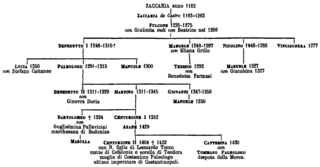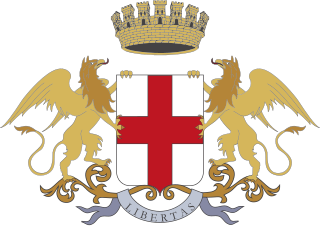
Chios is the fifth largest Greek island, situated in the northern Aegean Sea, and the tenth largest island in the overall Mediterranean Sea. The island is separated from Turkey by the Chios Strait. Chios is notable for its exports of mastic gum and its nickname is "the Mastic Island". Tourist attractions include its medieval villages and the 11th-century monastery of Nea Moni, a UNESCO World Heritage Site.
Year 1347 (MCCCXLVII) was a common year starting on Monday of the Julian calendar, and a common year starting on Sunday of the Proleptic Gregorian calendar.

Maona of Chios and Phocaea was a maona formed to exact taxes for the Republic of Genoa from the island of Chios and port of Phocaea. Genoa sold the rights to their taxes to the maona, which raised funds from its investors to buy galleys and eventually re-conquer Chios and Phocaea.

The Lordship of Chios was a short-lived autonomous lordship run by the Genoese Zaccaria family. Its core was the eastern Aegean island of Chios, and in its height it encompassed a number of other islands off the shore of Asia Minor. Although theoretically a vassal of the Byzantine Empire, the Zaccaria ruled the island as a practically independent domain from its capture in 1304 until the Greek-Byzantines recovered it, with the support of the local Greek population, in 1329. The island would return to Genoese control in 1346 under the Maona of Chios and Phocaea.

Martino Zaccaria was the Lord of Chios from 1314 to 1329, ruler of several other Aegean islands, and baron of Veligosti–Damala and Chalandritsa in the Principality of Achaea. He distinguished himself in the fight against Turkish corsairs in the Aegean Sea, and received the title of "King and Despot of Asia Minor" from the titular Latin Emperor, Philip II. He was deposed from his rule of Chios by a Byzantine expedition in 1329, and imprisoned in Constantinople until 1337. Martino then returned to Italy, where he was named the Genoese ambassador to the Holy See. In 1343 he was named commander of the Papal squadron in the Smyrniote crusade against Umur Bey, ruler of the Emirate of Aydin, and participated in the storming of Smyrna in October 1344. He was killed, along with several other of the crusade's leaders, in a Turkish attack on 17 January 1345.

Benedetto I Zaccaria was an Italian admiral of the Republic of Genoa. He was the Lord of Phocaea and first Lord of Chios, and the founder of Zaccaria fortunes in Byzantine and Latin Greece. He was, at different stages in his life, a diplomat, adventurer, mercenary, and statesman.
Jacqueline de la Roche, was sovereign baroness of Veligosti and Damala in 1308-1329, from 1311 in co-regency with her spouse.
The Venetian–Genoese Wars were a series of struggles between the Republic of Genoa and the Republic of Venice, at times allied with other powers, for dominance in the Mediterranean Sea between 1256 and 1381. There were four bouts of open warfare, in which the fighting between the two republics took place largely at sea. Even during periods of peace, incidents of piracy and other minor outbreaks of violence between the two trading communities were commonplace.

The Battle of Settepozzi was fought in the first half of 1263 off the island of Settepozzi between a Genoese–Byzantine fleet and a smaller Venetian fleet.
Benedetto II Zaccaria was the co-Lord of Chios, as well as many other Aegean islands from 1314 until ca. 1325.

Giovanni di Murta was elected the second Doge of the Republic of Genoa after the resignation of Simone Boccanegra, on 25 December 1345. His dogate was dominated by his attempts to break the circle of political violence which had crippled the city over the past century and to reassert Genoese dominion over the Mediterranean colonies.
Henry of Asti was the titular Latin Catholic patriarch of Constantinople from 1339 and bishop of Negroponte in Frankish Greece. His fame rests on his leadership of the first Smyrniote crusade (1342–45), on which he died.
The Battle of Chios was a naval battle fought off the shore of the eastern Aegean island of Chios between a Latin Christian—mainly Hospitaller—fleet and a Turkish fleet from the Aydinid emirate. The Christian fleet was victorious, but for the Aydinids, who had been engaging in piracy since the collapse of Byzantine power, it was only a temporary setback in their rise to prominence.
Leo Kalothetos was a provincial governor of the Byzantine Empire.
The Lordship of Phocaea was founded after in 1275, when the Genoese nobleman Manuele Zaccaria received the twin towns of Old Phocaea and New Phocaea as a fief from the Byzantine emperor Andronikos II Palaiologos. The Zaccaria family amassed a considerable fortune from their properties there, especially the rich alum mines. The Zaccaria held the lordship until 1340, when it was repossessed by the Byzantines under Andronikos III Palaiologos.
Tedisio Zaccaria was lord of Thasos and governor of Phocaea from 1302 to 1307. A descendant of the important Genoese family of Zaccaria, he was the son of Manuele Zaccaria and Clarisia Fieschi. His father was the brother of Benedetto I Zaccaria, the founder of Zaccaria fortunes in Byzantium and Latin Greece.
Andreolo Giustiniani was an antiquarian, humanist, literary patron, and writer of the Italian Renaissance.
The Zaccaria family was an ancient and noble Genoese dynasty.

The House of Damalas is a Genoese-Byzantine noble House established in the late 15th century; with roots originating from the island of Chios during the Genoese occupation. Created as a result of intermarriages among the Imperial House of Palaiologos with the Genoese noble House of Zaccaria.
In 1320, the Turks of Menteshe launched an unsuccessful attempt to conquer the island of Rhodes from the Knights Hospitaller.







